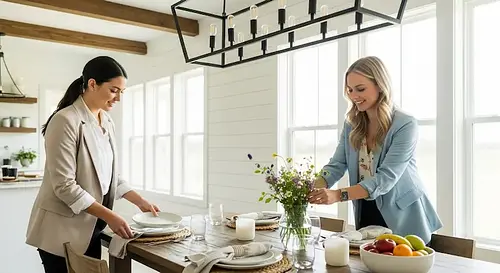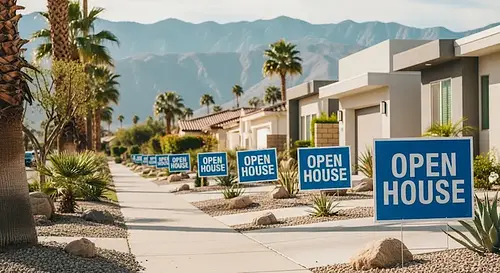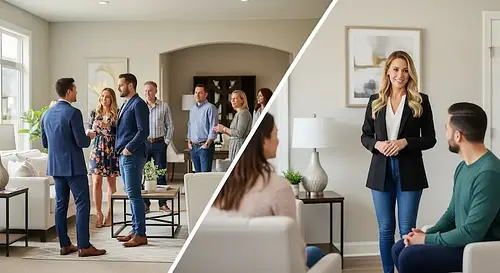What Is A Good Turnout For An Open House?
What is a good turnout for an open house? Whether you're hosting in an urban, suburban, or rural area, this guide breaks down how many visitors to expect—based on location, season, and day of the week. Learn what affects open house attendance, how to boost foot traffic, and why lead quality matters more than the total number of guests. Perfect for agents who want to turn every open house into a high-converting success.

Written by Seth Cox
Jul 07, 2025 / Open house marketing
The truth is, a good turnout for an open house depends on where, when, and how you host it. Urban listings typically see more walk-ins, while rural properties may have just a handful of serious buyers. Weekends draw bigger crowds than midweek showings, and seasonal trends can make or break your foot traffic.
In this article, we’ll explore what counts as a good open house turnout based on market type, day of the week, and time of year—plus how to set realistic expectations and focus on what really matters: lead quality and follow-up.
Related: How Many Open Houses Should You Have?
How Many People Typically Attend an Open House?
Entry-level homes in popular neighborhoods may draw 20 or more attendees, while higher-end or rural properties may only see a handful—but those visitors are often more serious. First open houses tend to attract the most traffic, with follow-up events seeing a gradual decline unless re-promoted with a fresh angle.
- 5–10 visitors: Common for slower markets, higher-end homes, or rural areas
- 10–20 visitors: Typical for well-promoted open houses in suburban areas
- 20–50+ visitors: More likely in dense urban markets or hot buyer environments
- Fewer than 5 visitors: Not ideal, but can still yield strong leads if marketed to the right audience

Open House Attendance by Area Type
Related: How To Host Open Houses When Farming A Neighborhood
Open House Attendance In Urban Areas
- 20–50+ visitors is common for condos and smaller homes in busy markets
- High-rise buildings and downtown properties benefit from easy drop-ins
- Marketing still matters, but location does much of the heavy lifting
Open House Attendance In Suburban Areas
- 10–20 visitors is considered a solid turnout
- Family-friendly neighborhoods tend to draw consistent interest
- Timing and local competition significantly impact traffic
Open House Attendance In Rural Areas
- 3–10 visitors is typical and often sufficient
- Homes may be farther apart, reducing spontaneous visits
- Lead quality tends to be high, even if the volume is low

Open House Turnout by Day of the Week
Open House Attendance on Weekends
- Sunday afternoons (12–3 PM) are the peak window
- Saturday mornings and early afternoons are also strong, especially in family-focused suburbs
- Expect higher turnout—typically 10–30+ visitors in active markets
Mid-Week Open House Attendance
- Turnout tends to be 3–10 visitors
- Best used for networking or early-listing strategy
- Timing should accommodate professionals—usually late morning to early afternoon
Open House Attendance on Friday Evenings
- 5–15 visitors is typical for well-marketed events
- Works best when paired with refreshments or unique staging
- Ideal for younger buyers or high-rise listings in walkable areas

Open House Attendance by Season
Average Open House Attendance In Spring
- Expect above-average turnout across most markets
- Families aim to buy before summer break
- Properties show well with better natural light and curb appeal
Average Open House Attendance In Summer
- Early summer open houses often perform well
- Weekday and evening options may help with schedule conflicts
- Turnout may drop in July and August in family-focused suburbs
Average Open House Attendance In Fall
- Steady attendance, especially for homes priced competitively
- Less competition from other listings compared to spring
- Crisp weather and seasonal staging can enhance the showing
Average Open House Attendance In Winter
- Lower volume—3 to 10 visitors may be a solid outcome
- Quality often outweighs quantity during this time
- Warm staging and lighting can help create a cozy impression

What Factors Influence Open House Turnout?
- Market conditions: In a hot seller’s market, more buyers are actively touring homes. In slower markets, even well-promoted open houses may have lower turnout.
- Price point: Lower-priced homes typically attract more visitors due to broader buyer interest. Luxury listings often see fewer, but more qualified, attendees.
- Marketing strategy: Listings with strong visuals, clear descriptions, and widespread promotion (MLS, social media, email, signage) consistently draw better traffic.
- Curb appeal and staging: A well-prepared home increases the likelihood that visitors will stop in, especially if they’re driving by.
- Competing events: If other major events or multiple open houses are happening at the same time, your traffic may split or drop off entirely.

How to Increase Turnout at Your Next Open House
- Promote across multiple platforms: Don’t rely on the MLS alone. Post your open house on Zillow, Realtor.com, Facebook, Instagram, and Google Business Profile.
- Leverage email and CRM lists: Send open house invites to your sphere of influence, past clients, and buyer leads. Make it personal and direct.
- Use targeted social media ads: Facebook and Instagram ads let you geo-target local buyers and renters who may not be actively searching but are open to the right opportunity.
- Place clear and abundant signage: High-contrast, directional signs at major intersections and neighborhood entry points drive local foot traffic.
- Engage the neighbors: Invite nearby homeowners to stop by. Even if they’re not buyers, they may refer someone—or become your next listing.

Why Lead Quality Matters More Than Quantity
-
Did you capture accurate contact information?
A digital or physical sign-in system is essential for follow-up. Without it, most leads vanish. -
Did you have meaningful conversations?
Prioritize quality interactions that reveal buyer intent, timelines, or agent representation. -
Did any visitors request a second showing or send an offer?
Even one strong lead can mean a win. -
Did you generate future business?
Many agents use open houses to meet neighbors, find potential sellers, or grow their database.

What to Do If No One Shows Up
- Review your promotion strategy: Double-check that the listing was posted in all the right places, the signage was visible, and invites went out in advance.
- Reconsider timing and competition: Was it scheduled during a holiday weekend, bad weather, or alongside multiple competing events? Small changes can make a big difference.
- Communicate transparently with your seller: Let them know what happened, what you learned, and how you plan to adjust. Proactivity builds trust.
- Use the time wisely: Take fresh listing photos, record a walk-through video, or go live on social media to give the home more exposure.
- Reschedule with improvements: A second open house with better timing, promotion, or staging can draw a very different outcome.

Conclusion: Redefining Open House Success in Today’s Market
A good open house isn’t just about foot traffic—it’s about opportunity. Did you meet a serious buyer? Capture new leads? Strengthen your relationship with the seller? Generate buzz in the neighborhood? These are the true markers of success.
By setting realistic expectations, focusing on lead quality, and refining your promotion strategy, you can turn any open house—big or small—into a productive step toward closing the deal or building your business.
The turnout is just the beginning. What you do with it is what really counts.
Sources and References
- National Association of Realtors - Seasonality In The Housing Market
Annual survey data showing how real estate activity changes throughout the year - National Association of Realtors (NAR) – Home Buyer and Seller Generational Trends Report
Provides data on buyer behavior, open house attendance habits, and seasonal trends. - NAR – Profile of Home Buyers and Sellers
Annual survey data showing how many buyers attend open houses and their impact on buying decisions. - HomeLight – What Happens At An Open House
Offers anecdotal evidence and agent survey data on what constitutes a successful open house. - Zillow - Consumer Housing Trends Report
Covers buyer preferences including how they search for homes, attend open houses, and use listing platforms. - Redfin – Do Open Houses Really Make A Difference?
Breaks down agent experiences and turnout metrics based on Redfin’s internal data. - ShowingTime – Seasonal Real Estate Activity Index
Useful for citing open house and showing traffic by season. - Inman – Broker Insights on Open House Effectiveness
Aggregates professional opinions and strategies for turnout and follow-up.






